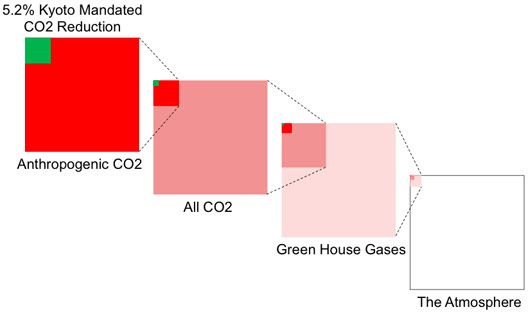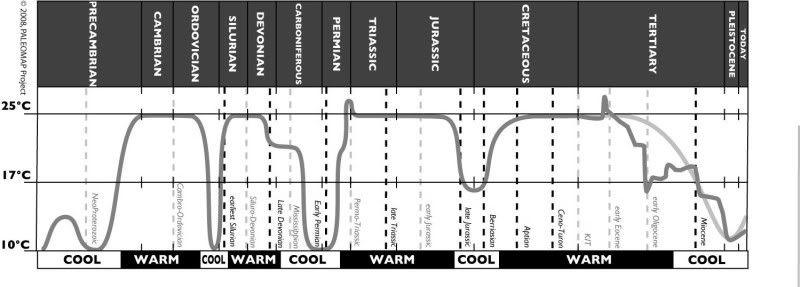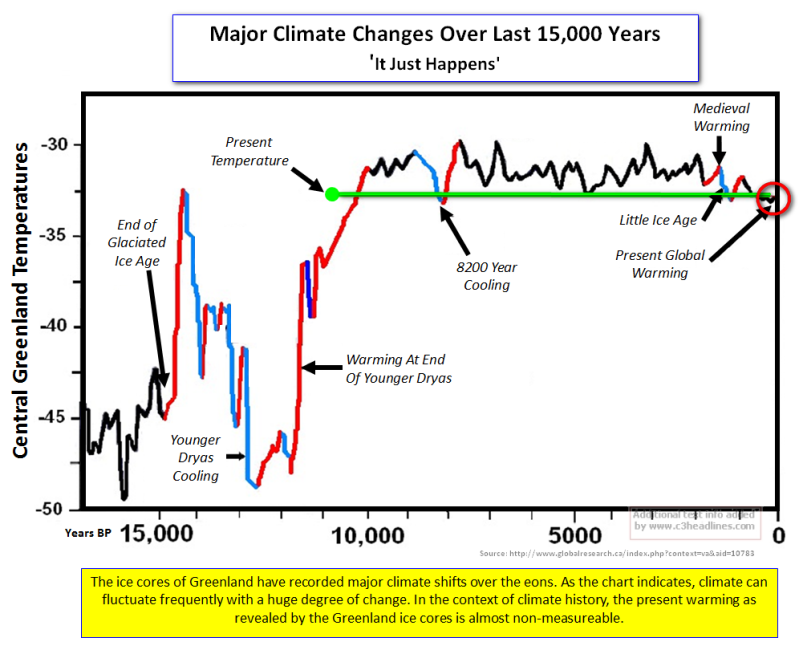Similarly, arguments about the effects of human activities on warming rage without establishing whether carbon dioxide significantly effects warming, or even if warming is good or bad.
So this discussion should begin at the beginning.
Is the Earth warming? Yes, at a rate of about 1º Fahrenheit (F) per century for the past two centuries, which coincidentally is the period since the end of the Little Ice Age.
Has there been similar warming in the past 1,000 years? Yes, in the Medieval Warm Period.
Has there been similar warming in the past 10,000 years? Yes, six or more, one of which – the Holocene Optimum – was much warmer.
Have there been periods of similar or greater warming in earlier periods? Yes, hundreds of them.
Were previous warming periods caused by increased atmospheric CO2? No, although Al Gore mistakenly said they were.
Is the current warming caused by increased atmospheric CO2? No, it’s just a continuation of the warming that began about four hundred years ago and ended the Little Ice Age.
Are sea levels rising? Yes, recently about six inches per century.
Have sea levels risen in the past? Yes, over 400 feet since the end of the last Ice Age 11,000 years ago.
Have sea levels ever been higher than they are now? Yes, hundreds of feet higher.
See how simple it is? We have already demonstrated that warming is not unusual. For that matter, cooling isn’t either. Neither are rising sea levels, or falling ones.
Does this surprise anyone? It shouldn’t, and you don’t have to be a climate expert, meteorologist, rocket scientist, mathematician, failed presidential candidate, or any other exalted personage to understand that climate change is natural, and has been for billions of years. The evidence is all around us.
However, historians and geologists are probably our best guides to past climate changes. Historians can tell us that the Thames would freeze over in the winter during The Little Ice Age, and that Ice Faires were held on it. Or that there were vineyards in England a thousand years ago where there aren’t now. Or that Vikings farmed parts of Greenland during the Medieval Warm Period that are in permafrost today, and that these farms and Viking settlement of Greenland failed as The Little Ice Age took hold.
Geologists can point out ancient beaches hundreds of feet above the current sea level, or channels once cut by rivers that are now under the sea.
Arrayed against these clear and simple facts, we find a so-called science that claims our current warming is caused by human activities that have increased atmospheric carbon dioxide. Further, according to Al Gore, carbon dioxide is “the most important of the so-called greenhouse gases”, and greenhouse gases cause warming. Beside the easily proven scientific fact that the greenhouse effect is a myth, such arguments begin from a premise that is in itself in error. First, water vapor, not CO2, is obviously the most important since it comprises 95 percent of total so-called atmospheric greenhouse gases. CO2 is a piddling (meaning very small) part of the total – almost four percent.
Carbon dioxide is a trace gas and is less than 0.04% of the atmosphere (Dry air contains roughly [by volume] 78.09% nitrogen, 20.9% oxygen, 0.93% argon, 0.039% carbon dioxide, and small amounts of other gases). Following this line of discovery, the next logical step would be to determine how much of the miniscule portion of air that is carbon dioxide results from human activity. Again, the word miniscule fits our needs, since natural sources (such as decaying vegetation) produce about 97%, and human activities produce only three percent. Therefore, human activity produces 0.001% of the volume of the atmosphere, or looking at just greenhouse gases, 0.12%. (click on this link)
Or, “Much ado about nothing.”
This chart illustrates that the green portion representing Kyoto mandated carbon dioxide reductions is about 1/20th of human-produced CO2, and that when taken in the context of the entire atmosphere achieves monumental insignificance, as does anthropogenic CO2.

“Nothing? Nothing, you say. Don’t you know that if it weren’t for the greenhouse effect, we’d all freeze?”
To which I succinctly reply, “male bovine excrement!”
Actually, opportunities to be frozen have appeared frequently in Earth’s history, although more often the Earth has been warmer and ice free. We’re now in a cool period, and have had polar ice for the past 35 million years, but for roughly 75% of its history the Earth has been ice free. This chart shows Earth’s most recent temperature history, beginning roughly 542 million years ago with the Cambrian period.

Our atmosphere does not operate as a greenhouse. A greenhouse has a cover which allows visible light to enter and to be absorbed as heat energy by the contents of the greenhouse. This heat energy then warms the air in the greenhouse through radiation, and the warm air is trapped inside the greenhouse and is prevented from mixing with the colder air outside.
Did Al get the science right?
In his introduction to “An Inconvenient Truth” Al Gore states: “I have learned that, beyond death and taxes, there is at least one absolutely indisputable fact. Not only does human-caused global warming exist, but it is also growing more and more dangerous and at a pace that has now made it a planetary emergency.”Later Gore quotes Mark Twain: “It ain’t what you don’t know that gets you into trouble, it’s what you know for sure that just ain’t so.” Al’s “absolutely indisputable fact” is just the sort of statement that Twain would have covered by his admonition.
By my count Gore listed at least three “facts”, none of which are indisputable. We’ve already demonstrated that warming can, and has, existed without human causation. We’ve shown the Earth has been warmer without producing catastrophic conditions. As we will later show, we can’t say the same about cooling.
Our world is filled with the unbelievable, yet Al Gore’s “An Inconvenient Truth” deserves a featured place in the “Great Hall of Unbelievables.” At the most basic level, Gore got the science wrong, yet some scientists praise him, even when these same scientists must concede that Al’s predictions are unrealistic – none believe sea levels could rise 20 feet by 2100 – they mute their criticism with remarks like “Gore got the science right.”
But did he get the science right? If so, then what has driven previous periods of climate change that have been equal or greater than the present? Are prominent scientists saying that CO2 is (and by implication has always been) the driving force in climate change?
Al Gore certainly did when he showed the chart of fluctuations of CO2 and temperatures derived from Vostok ice core samples, and said that rising atmospheric CO2 levels caused global temperatures to rise. However, and very inconveniently for Al, the Vostok studies actually show that temperatures rose before CO2, and furthermore, that temperatures fell while CO2 levels were still high. For the last almost half-a-million years covered by the Antarctic ice core samples taken at Vostok, temperature changes drive CO2 changes (not vice versa)with a lag time ranging 500 to 1,500 years.

Only briefly chastened by the Vostok revelations, anthropogenic (man-caused) global warmists concede that rising temperatures (resulting from orbital and solar variations) cause rising CO2, but then theorize that rising CO2 takes over and forces a much greater increase in temperature than possible without CO2’s contribution to the greenhouse effect.
Interestingly, while they weaseled out of the box they found themselves in when rising temperatures cause increasing levels of atmospheric CO2, they’re still stuck in the box because they can’t explain why temperatures fall before all-powerful CO2 does.
And temperatures have always fallen after rising, regardless of CO2 levels.
In fact, it’s happened many times in the last 10,000 years, after our most recent Ice Age ended 11,000 years ago. Since Al Gore has made much of Greenland, and what he sees as the potential for the Greenland ice cap to be dislodged dramatically by warming and cause sea levels to suddenly rise 20 feet, it behooves us to look at what Greenland ice cores tell us about the past 15,000 years. Talk about your warming! Only 15,000 years ago Greenland warmed 22º F (12.5º C) in only 1,000 years, plunged 29º F (16º C) back into cooling, then surged upwards over 30º F (17º C), all in only 4,000 years. Then, except for two very brief periods, Greenland temperatures remained significantly higher than the present for more than 10,000 years.

The following chart shows temperatures peaked almost 8,000 years ago and that succeeding peak temperatures have been steadily lower. The chart ends at Year 0 (2004), and clearly shows the warmer Medieval Warm Period roughly 1,000 years ago, and the recent very cold Little Ice Age (1200 to 1800 AD) that we are recovering from at a rate of about 0.5º Centigrade per century.

Unprecedented warming?
Al displayed the infamous “Hockey stick” graph (created by Dr. Michael Mann et al, famous in Climategate disclosures for his trick to “hide the decline”) in “An Inconvenient Truth” which wiped out both the Medieval Warm Period and The Little Ice Age. Al then trumpeted that current warming was “unprecedented”, leaving one to wonder what Al thinks “unprecedented” means. I think I know what it means, but to be sure I checked the dictionary and found I’m right and Al’s wrong. Unprecedented means “it ain’t happened before” (I’m paraphrasing). One dictionary showed: “without previous instance; never before known or experienced; unexampled or unparalleled”.
Unprecedented warming does not mean in the past 100 years, 500 years, 1,000 years, &etc. I suppose you could say that something is unprecedented in your lifetime, or since instrumental temperature records began (Gabriel Fahrenheit invented the mercury thermometer in 1724). However, if you say that the current warming is unprecedented, you had better include a qualifier like “since the end of the Medieval Warm Period approximately 1300 AD”.
In recent history (the past one-hundred million years – see the following chart), average global temperature was steady at about 21º C (a balmy 70º F) for most of the period while atmospheric CO2 fell 75%, from 1,500 parts per million (ppm) to the present 380 ppm. This chart also shows we now live in a low-atmospheric CO2 environment compared to over a half-billion years ago when CO2 was 7,000 ppm. Only for a brief period (in geologic terms) 315 to 270 million years ago has both CO2 and temperatures been as low as now. Obviously, for a long time temperature not only has had a low correlation with CO2, but has been insensitive to changes in CO2. That’s what you would expect, since the Greenhouse Effect is a myth, a now-and-again coincidence that does not even fit the past fifty-year period of intermittent warming.

The Greenhouse Effect myth - Or the power of coincidence
“One of the most important factors is the greenhouse effect; a simplified explanation of which is as follows. Short-wave solar radiation can pass through the clear atmosphere relatively unimpeded. But long-wave terrestrial radiation emitted by the warm surface of the Earth is partially absorbed and then re-emitted by a number of trace gases in the cooler atmosphere above. Since, on average, the outgoing long-wave radiation balances the incoming solar radiation, both the atmosphere and the surface will be warmer than they would be without the greenhouse gases … The greenhouse effect is real; it is a well understood effect, based on established scientific principles."
The above sounds very neat. It’s too bad it’s wrong.
The abstract below, Falsification Of The Atmospheric CO2 Greenhouse Effects Within The Frame Of Physics, Version 3.0 (September 9, 2007)” was authored by two German physicists, Gerhard Gerlich and Ralf D. Tscheuschner.
“The atmospheric greenhouse effect, an idea that authors trace back to the traditional works of Fourier 1824, Tyndall 1861, and Arrhenius 1896, and which is still supported in global climatology, essentially describes a fictitious mechanism, in which a planetary atmosphere acts as a heat pump driven by an environment that is radiatively interacting with but radiatively equilibrated to the atmospheric system. According to the second law of thermodynamics such a planetary machine can never exist. Nevertheless, in almost all texts of global climatology and in a widespread secondary literature it is taken for granted that such mechanism is real and stands on a firm scientific foundation. In this paper the popular conjecture is analyzed and the underlying physical principles are clarified. By showing that (a) there are no common physical laws between the warming phenomenon in glass houses and the fictitious atmospheric greenhouse effects, (b) there are no calculations to determine an average surface temperature of a planet, (c) the frequently mentioned difference of 33º C is a meaningless number calculated wrongly, (d) the formulas of cavity radiation are used inappropriately, (e) the assumption of a radiative balance is unphysical, (f) thermal conductivity and friction must not be set to zero, the atmospheric greenhouse conjecture is falsified.”
The authors concluded their study hopefully: “The authors express their hope that in the schools around the world the fundamentals of physics will be taught correctly and not by using award-winning "Al Gore" movies shocking every straight physicist by confusing absorption/emission with refection, by confusing the tropopause with the ionosphere, and by confusing microwaves with shortwaves.”
Once the anthropogenic global warmists have their greenhouse effects taken away, what remains?
4 comments:
I live on the east coast of Australia and we just had more rain then ever recorded on paper, although the background geology has records of far worse, and it continues. Sure we lost our car, house, furniture etc, but theyre only atoms and there's lots more where they came from. Al Gore forgot that at these times people get together and prove that there is hope for us stupid earthlings. I met family and friends I havent seen for 20 years, and made new friends, all came to help out. We havent laughed so much for years. Climate change is certain, as it always has been, and arguing about it is not constructively adapting to the changes, after all, we're all in it together and we should stop arguing and work together.
Perhaps photos are more then atoms.
Beem
My family wishes your family and friends a speedy recovery. I was looking at flood records for the Ipswich area, and it looks like there have been many big ones since the early 1800's, and evidence of many even larger before. It appears that storms during the Little Ice Age (1600 to 1800 AD) were particularly strong and nasty worldwide, even worse than the worst Al Gore says threatens us now. Every dollar we spend on trying to stop natural climate change is a dollar better spent on adapting to it.
You Cobbers are the best mates we Yanks have in the world, and we're hoping all will be well soon.
What's left is to stop worring about the devil that caused this and start prepairing for the consiquences of a warmer planet.
Paul
Don't forget to also prepare for the consequences of a colder planet. Temperature reconstructions for the past 900,000 years show long glacial periods (approximately 100,000 years each) interspersed with short interglacial periods (about 20,000 years). We have had six warm periods since the end of the Ice Age 15,000 years ago. The warmest was the Holocene Optimum right after the end of the Ice Age, and the least warm of the warming periods is the current one. The historical record shows we are easing into another glacial period, not increased warming.
Post a Comment